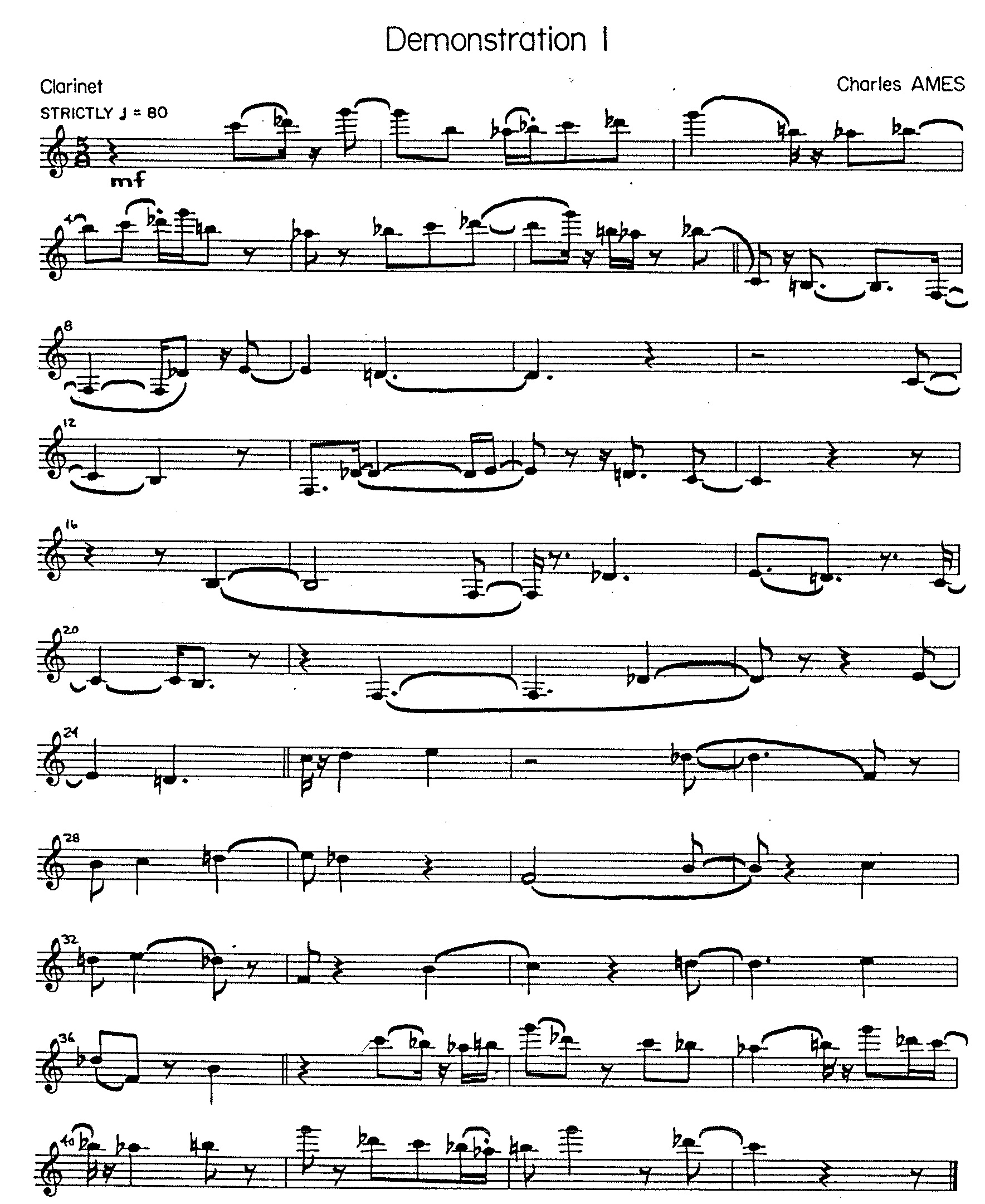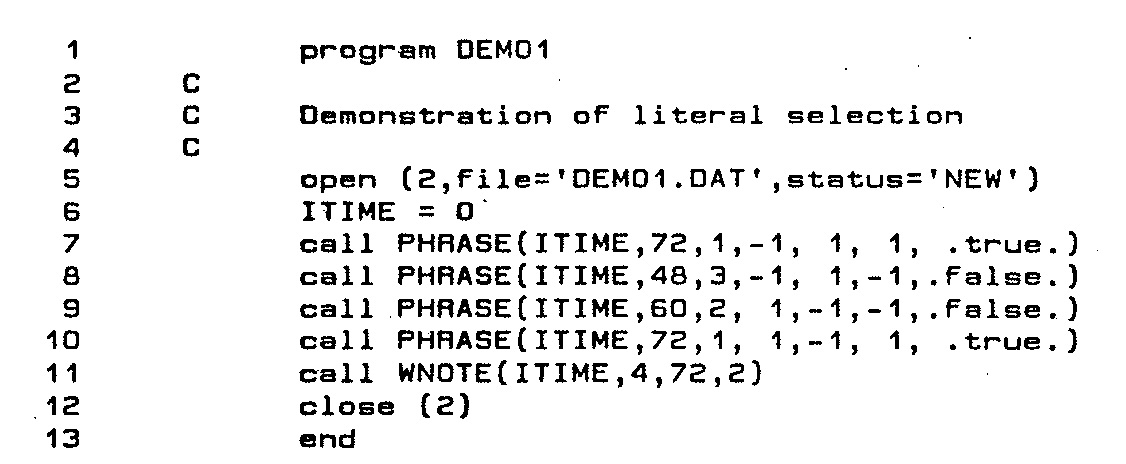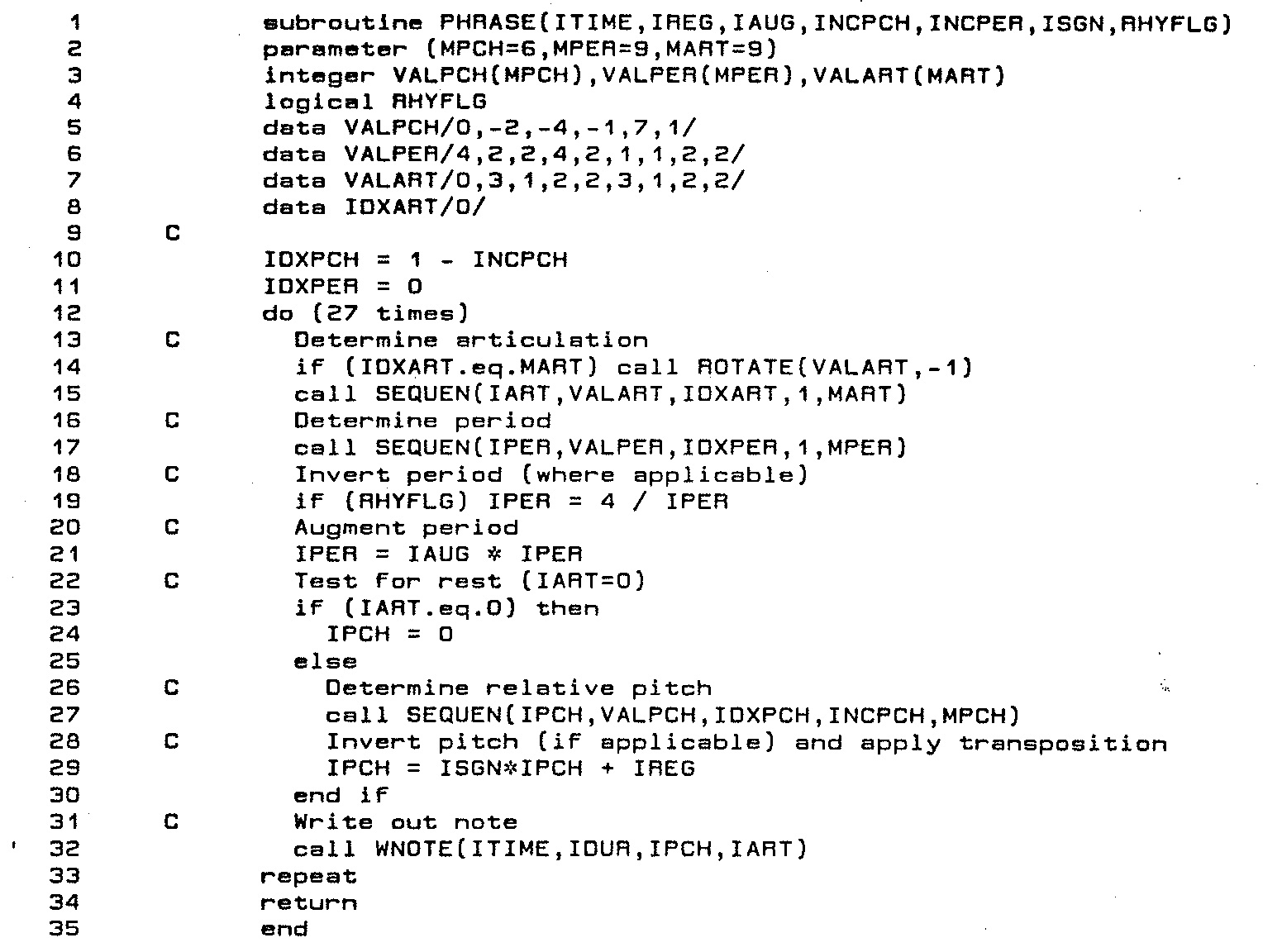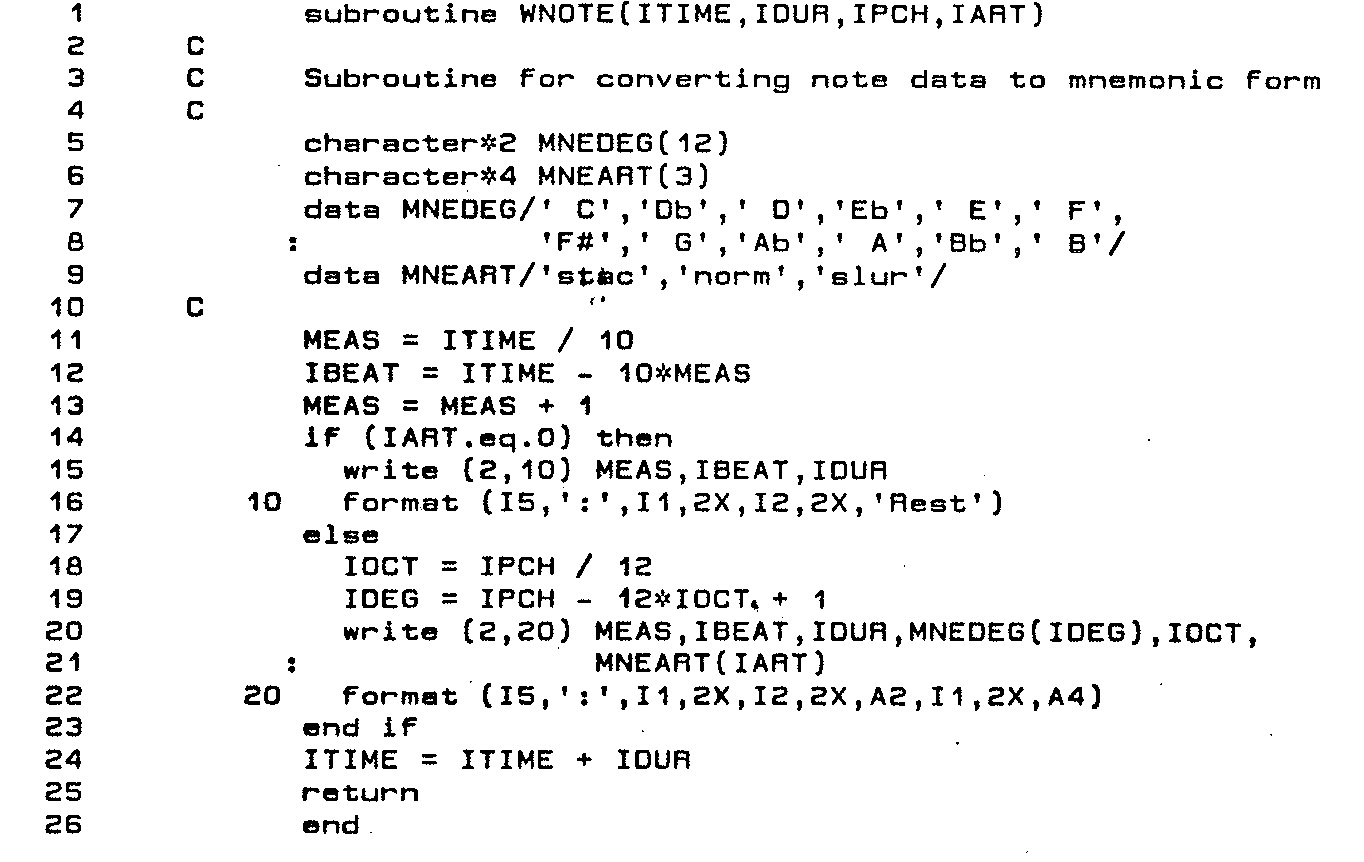Demonstration 1
Literal Selection
Introduction
Demonstration 1 provided the practical component for Chapter 3: “Literal Selection” of my unpublished textbook on composing programs. It illustrates the basic design of a complete composing program. In particular it shows how a composer might implement literal strategies to derive not only the musical details, but also the broader level of musical structure.
From the perspective of my production framework, the process as a whole is a single problem interleaving decisions about phrase attributes with decisions about note attributes. What distinguishes this Demonstration from all others is that its decisions implement the degenerate scenario known as Hobson's choice. Except that this composing program does not have the luxury of trying another stable.
Compositional Directives
The piece derives entirely from the three rows depicted in Figures 1 (a), 1 (b), and 1 (c). It has three levels of structure: the local level consists of individual notes; the median level consists of 24-note phrases; and the global level consists of the piece as a whole, which spans four entire phrases.
Each phrase in Demonstration 1 constitutes a resultant created by phasing four cycles of the pitch row against three cycles of the period row. Figure 2 illustrates how the opening resultant of the piece is derived. Concurrent with each cycle of periods is a cycle of the nine articulations. Notice that the cycles of pitches and periods come back into alignment at the end of the phrase because one element in each cycle of articulations is always a rest.
| Measure | Pitches | Periods |
|---|---|---|
| 1 | High Register Retrograde |
No augmentation Prime form |
| 7 | Low Register Retrograde - inversion |
Augmentation by 2 Inversion |
| 25 | Medium Register Inversion |
Augmentation by 3 Retrograde - inversion |
| 37 | High Register Prime form |
No augmentation Retrograde |
Table 1: Global recipe for Demonstration 1.
Table 1 gives the layout of Demonstration 1 and details which transformations have been applied to the pitch and period rows in each phrase. Here are the outcomes from a decision-making process which, rather than being delegated to the computer, was undertaken prior to the automated phase of production. But you can see criteria at work which, with greater programming sophistication, could conceivably have been programmed. For example, the series forms (prime, inversion, retrograde, retrograde-inversion) are each employed once for pitches and once for durations; also, pitch and rhythm never employ the same series form in the same phrase. Also, registers cycle through high, low, and medium before recapping with high register in the fourth phrase. Likewise, augmentations cycle through 1×, 2×, and 3× before recapping with 1×.
The complete musical product appears in Figure 3.
Implementation
The explanations to follow focus on three musical attributes: pitch, timing (approached through the notion of periods between consecutive attacks), and articulation. Their purpose is to tease out the strands of code that affect a particular attribute, and thus to reveal the mechanics of literal selection in play. The explanations are peppered with line numbers identifying where precisely the various declarations, data initializations, loops, branches, calculations, and subroutine calls may be found in the printed listing. Yet these line numbers will distract your focus from attribute-specific strands to the greater mass of code. You are by no means expected to chase down every line of code. Rather, you should follow through with line numbers only when you have a specific question that the narrative is not answering.
The design of DEMO1 reflects a structure of phrases and notes:
-
Attributes affecting entire phrases are determined by the main program,
DEMO1proper. The source code forDEMO1appears as Listing 1. -
Attributes affecting individual notes are calculated by subroutine
PHRASE, whose source code appears as Listing 2. -
Subroutine
PHRASEreceives support from the library subroutineSEQUEN. -
Data describing each note is then converted into human-readable text by subroutine
WNOTE, whose source code appears as Listing 3.WNOTEalso writes this text out to the file named “DEMO1.DAT”.
Phrases
Lines 7-10 of program DEMO1 implements the layout through four
calls to subroutine PHRASE.
PHRASE receives information from Table 1 through seven
explicit arguments:
-
ITIME— Phrase start time in sixteenth notes. -
IREG— Register expressed as an offset; 0 indicates 32' C. -
IAUG— Augmentation factor, used to multiply note durations. -
INCPCH— Increment for pitch row: 1 indicates forward; -1 indicates retrograde. -
INCPER— Increment for period row: 1 indicates forward; -1 indicates retrograde. -
ISGN— Direction for pitch row: 1 indicates original; -1 indicates inversion. -
RHYFLG— Flag for period inversion: If false, original period values are used; if true, period values (1, 2, or 4) are divided into 4.
A final call to subroutine WNOTE (line 11) acts to close the piece on a quarter-note C5 with normal articulation.
The source code for subroutine PHRASE appears as Listing 2.
The symbols in PHRASE are associated with musical attributes through three abbreviations:
-
PCH— pitch, expressed as an offset from the first note in the row. ParameterMPCH(line 2) sets the length of the pitch row to 6. ArrayVALPCHholds the pitch row. This array is populated in line 5, with contents expressed as offsets relative to the starting pitch. VariableIDXPCHtracks the current pitch-row position. -
PER— period between consecutive attacks. ParameterMPER(line 2) sets the length of the period row to 9. Array VALPER holds the period row. This array is populated in line 6, with values indicating 1, 2, or 4 sixteenth notes. VariableIDXPERtracks the current period-row position. -
ART— articulation. ParameterMART(line 2) sets the length of the articulation row to 9. Array VALART holds the articulation row. This array is populated in line 7, with values indicating 0 (rest), 1 (staccato), 2 (normal), 3 (slur). VariableIDXARTtracks the current articulation-row position.
Sequences
The library subroutine SEQUEN1
is modeled on the SEQUENCE feature of G.M. Koenig's Project Two.
It implements the most basic of literal procedures; that is, sampling elements in order from a row.
Calls to SEQUEN require five arguments:
-
RESULT—SEQUENselects a new element from a row and returns the row value in this location. -
VALUE— Supply of values arranged in position order. Duplicate values are permitted.VALUEmust be an array in the calling program whose dimension in the calling program isNUM(argument #5 below). -
IDX— Index to pending selection.IDXmust be an integer in the calling program. Before anything else,SEQUENincrementsIDXbyINC(argument #4 below). WheneverIDXthreatens to move outside the range from 1 toNUM,SEQUENperforms wrap-around arithmetic to restoreIDXinto range.SEQUENcompletes by settingRESULT=VALUE(IDX). InitializingIDXto1-INCcauses the first call toSEQUENto return the first element ofVALUE. -
INC— Sampling increment.INCmust be an integer in the calling program. It can be either positive or negative (settingINCto -1 produces the retrograde) but it should always be relatively prime toNUM. -
NUM— Number of row elements (dimension of arrayVALUEin the calling program).
Notes
The length of each row is given by a parameter starting with the letter M;
values of the prime row-forms reside in arras beginning with VAL.
Each row also has an associated index beginning with IDX.
The transformations used to generate additional material for Demonstration 1 break down as follows:
-
Pitches
-
Transpositions: transpositions are determined by variable
IREG(line 29 ofPHRASE). All transpositions in Demonstration 1 occur at the octave. -
Intervallic inversions: the variable
ISGN(line 29) determines whether offsets from arrayVALPCHgo upward (ISGN * IPCHpositive) or downward (ISGN * IPCHnegative). -
Retrogrades: the variable
INCPCHdetermines whether SEQUEN selects offsets by sampling forward or backward through arrayVALPCH(line 27). -
Retrogrades: the variable
INCPER(line 17 ofPHRASE) determines whetherSEQUENselects periods by sampling forward or backward through arrayVALPER. -
Rhythmic inversions: the logical variable
RHYFLG(line 19) determines whether or notPHRASEshould invert the relative periodIPER. -
Augmentations: multiplying by the variable
IAUG(line 21) converts the relative periodIPERinto an absolute period.
VALART (line 15).
Each complete cycle through VALART causes PHRASE to rotate each element of VALART by one position
by initiating a call (line 14) to the library subroutine ROTATE.
Rotation
The library subroutine ROTATE2 accepts an array of arbitrary
dimension and shifts the elements of the array by an arbitrary number of positions. Calls to ROTATE require
three arguments:
-
VALUE— Array of values, arranged in position order.VALUEin the calling program must be an array of dimensionNUM(argument #3 below). -
NSHIFT— Number of positions each element is to shift. IfNSHIFTis positive, then the shift will be rightward/clockwise; ifNSHIFTis negative, then the shift will be leftward/counter-clockwise. -
NUM— Number of row elements (dimension of arrayVALUEin the calling program).
Text Output
The mechanics of subroutine WNOTE bear close attention because they serve for most the of Demonstrations
in this series. When it calls WNOTE to append a note to the human-readable listing, DEMO1 provides four
arguments:
-
ITIME— Start time in sixteenth notes. -
DUR— Duration in sixteenth notes. -
IPCH— Pitch, expressed as in integer offset from 32'C. -
IART— Articulation: (0) rest, (1) staccato, (2) normal, (3) slur.
The first task of WNOTE is to place ITIME in a measure (lines 8-19).
The author finds it most convenient to begin measures on beat 0.
Conversion of numeric degrees to letter names is easily accomplished using the character array LETTER.
The convention is to express registers in octaves above 32'C (making 32'C C0; middle C is C4; A 440 is A4, and so on).
The character array ARTIC converts numeric articulations into readable text indications.
Comments
-
Subroutine
SEQUENis described in Automated Composition, Chapter 3, pp. 3-8 to 3-9. -
Subroutine
ROTATEis presented in Automated Composition, Chapter 3, pp. 3-13 to 3-15.
| © Charles Ames | Original Text: 1984-11-01 | Page created: 2017-03-12 | Last updated: 2017-03-12 |







